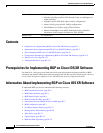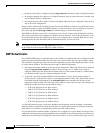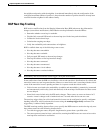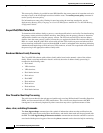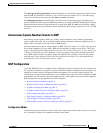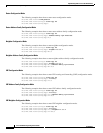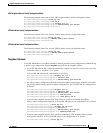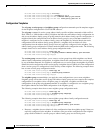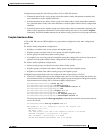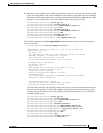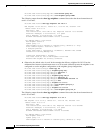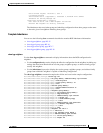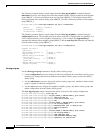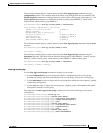
Implementing BGP on Cisco IOS XR Software
Information About Implementing BGP on Cisco IOS XR Software
RC-10
Cisco IOS XR Routing Configuration Guide
OL-14356-01
RP/0/RP0/CPU0:router(config-bgp)# vrf vrf_A
RP/0/RP0/CPU0:router(config-bgp-vrf)# neighbor 11.0.1.2
RP/0/RP0/CPU0:router(config-bgp-vrf-nbr)# address-family ipv4 unicast
RP/0/RP0/CPU0:router(config-bgp-vrf-nbr-af)# route-policy pass all in
Configuration Templates
The af-group, session-group, and neighbor-group configuration commands provide template support
for the neighbor configuration in Cisco IOS XR software:
The af-group command is used to group address family-specific neighbor commands within an IPv4,
IPv6, VPNv4, or VPNv6 address family. Neighbors that have the same address family configuration are
able to use the address family group (af-group) name for their address family-specific configuration. A
neighbor inherits the configuration from an address family group by way of the use command. If a
neighbor is configured to use an address family group, the neighbor (by default) inherits the entire
configuration from the address family group. However, a neighbor does not inherit all of the
configuration from the address family group if items are explicitly configured for the neighbor. The
address family group configuration is entered under the BGP router configuration mode. The following
example shows how to enter address family group configuration mode.
RP/0/RP0/CPU0:router(config)# router bgp 140
RP/0/RP0/CPU0:router(config-bgp)# af-group afmcast1 address-family ipv4 multicast
RP/0/RP0/CPU0:router(config-bgp-afgrp)#
The session-group command allows you to create a session group from which neighbors can inherit
address family-independent configuration. A neighbor inherits the configuration from a session group
by way of the use command. If a neighbor is configured to use a session group, the neighbor (by default)
inherits the entire configuration of the session group. A neighbor does not inherit all of the configuration
from a session group if a configuration is done directly on that neighbor. The following example shows
how to enter session group configuration mode:
RP/0/RP0/CPU0:router(config)# router bgp 140
RP/0/RP0/CPU0:router(config-bgp)# session-group session1
RP/0/RP0/CPU0:router(config-bgp-sngrp)#
The neighbor-group command helps you apply the same configuration to one or more neighbors.
Neighbor groups can include session groups and address family groups and can comprise the complete
configuration for a neighbor. After a neighbor group is configured, a neighbor can inherit the
configuration of the group using the use command. If a neighbor is configured to use a neighbor group,
the neighbor inherits the entire BGP configuration of the neighbor group.
The following example shows how to enter neighbor group configuration mode:
RP/0/RP0/CPU0:router(config)# router bgp 123
RP/0/RP0/CPU0:router(config-bgp)# neighbor-group nbrgroup1
RP/0/RP0/CPU0:router(config-bgp-nbrgrp)#
The following example shows how to enter neighbor group address family configuration mode:
RP/0/RP0/CPU0:router(config)# router bgp 140
RP/0/RP0/CPU0:router(config-bgp)# neighbor-group nbrgroup1
RP/0/RP0/CPU0:router(config-bgp-nbrgrp)# address-family ipv4 unicast
RP/0/RP0/CPU0:router(config-bgp-nbrgrp-af)#
• However, a neighbor does not inherit all of the configuration from the neighbor group if items are
explicitly configured for the neighbor. In addition, some part of the configuration of the neighbor
group could be hidden if a session group or address family group was also being used.



